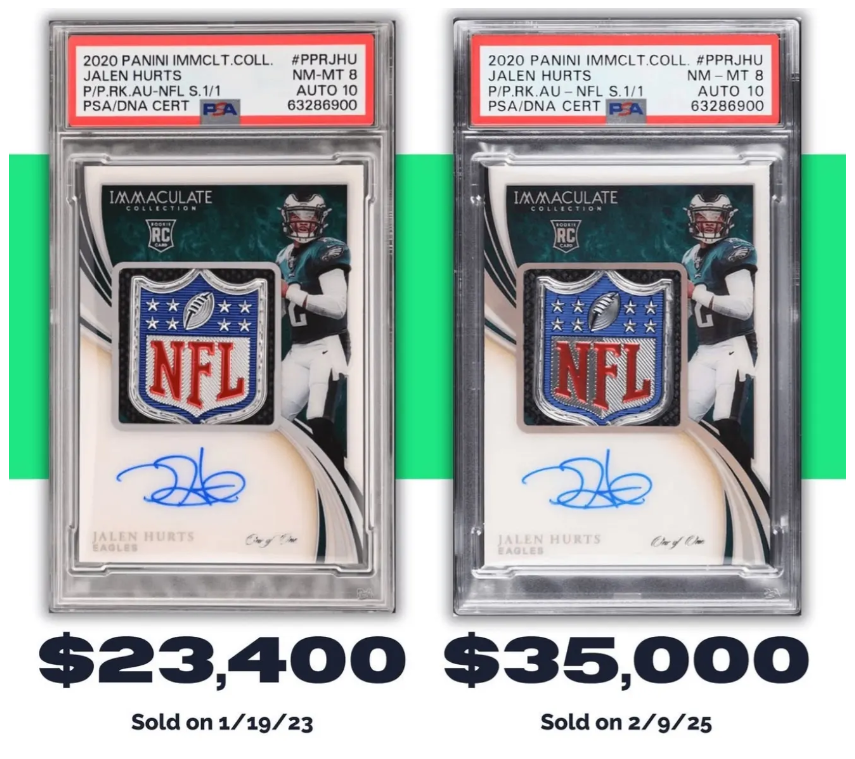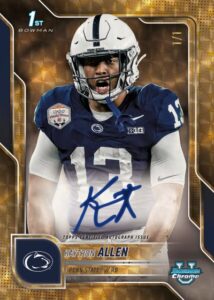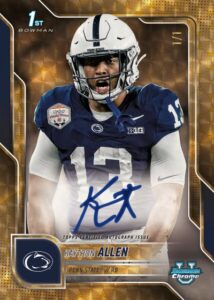In the world of sports memorabilia and the trading card market, few events drive excitement quite like a Super Bowl MVP performance. Such was the case for Jalen Hurts, whose Super Bowl LIX feats not only crowned him a champion on the field but also seemingly ordained him a king of the collectibles market. As confetti settled on the field, sparks flew in online marketplaces, with Hurts’ 2020 Panini Immaculate Collection 1/1 NFL Shield Auto (a mouthful of a treasure, indeed) selling for an astonishing $35,000 on the very night of the Super Bowl.
For those keeping track, this price tag represents a jaw-dropping leap from the $23,400 recorded in January 2023 for the exact same card. A leap indicative of Hurts’ meteoric rise, it prompts the inevitable debate among collectors and investors alike—have we reached the summit of Hurts’ market, or is this ascent just beginning its climb?
Let’s dissect what’s fueling this price surge. First and foremost, Hurts has emerged not just as a talented quarterback, but as a full-blown NFL superstar. His transition from a promising young player making his Super Bowl debut to a bona fide champion and MVP has cemented his status among the league’s elite, leading to a collector frenzy.
History tells us that quarterbacks who don those iconic championship rings often become hot commodities in the trading card world, basking in long-term appreciation from jubilant investors. The freshly minted MVP honors further boost Hurts’ memorabilia value—as now he belongs to an elite cohort, destined to be etched in the annals of the sport. Add to this the already robust climate of the high-end sports card market, and you see why Hurts’ cards are in high demand.
Yet, skepticism remains. With a card selling at such a lofty figure, does it represent Hurts’ market pinnacle, or merely a foothill on a mountaineering journey?
To approach this conundrum, it helps to look at the historical peaks reached by cards of elite quarterbacks. Patrick Mahomes’ rookie patch autos, for example, have surpassed the $100K mark, especially post his second Super Bowl win. Then there’s Tom Brady, whose rookie cards regularly break into seven-figure territory—a testament to his legendary, decorated career.
Hurts’ future in the trading card market hinges on quite a few variables. Sustaining high performance is critical; consistently making deep playoff runs becomes essential, and ultimately, carving out a Hall of Fame-worthy career could skyrocket his card prices further into rarified air.
The question on collectors’ and investors’ lips, however, boils down to those age-old financial advisories: to buy, sell, or hold? Each decision carries its risks and rewards.
For the bold believer in Hurts’ potential to accumulate multiple rings over the coming seasons, a buying window may have opened—an opportune moment to enter the fray before another price surge swells up the market.
Conversely, sellers might see this post-Super Bowl high as a golden opportunity to cash out and savor profits before the NFL offseason ushers in the usual market cooldown.
Hold, though, is the trusty mantra for those betting on a legacy not yet realized. The prudent watch-and-wait game may pay dividends should Hurts continue to shine under that blazing spotlight.
Lastly, the broader sports card market itself introduces additional layers of unpredictability. High-end 1/1 rookie cards, like the one bearing Hurts’ signature, trade so infrequently that broader market trends cast a cloud over predicting their future trajectory.
What truly happens to Hurts’ card market now hinges on offseason demand, waiting for the 2025 season kickoff to illuminate future trends. Hurts, with his Super Bowl ring and MVP accolade, has his collectible market buzzing. Yet, whether the $35,000 sale is but a pitstop on his card’s journey—or indeed, the zenith of its climb—remains an enthralling storyline for collectors and investors to track as the seasons unfold.





